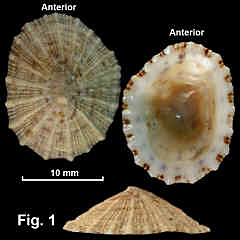|
|
SIPHONARIIDAE |
|
|
|
Siphonaria zelandica Quoy & Gaimard, 1833 Description: Shell usually eroded; low, height less that 1/3 of length, sides straight to concave. Apex slightly to rear of centre. Sculptured with 15-20 low primary radial ribs, more or less equal in size, sometimes projecting weakly at margins, with 2-6 secondary ribs between each primary. Primary ribs white, area between primaries mottled or striped white and brown. Interior with horseshoe-shaped muscle scar and shallow siphonal groove from apex to margin on right of shell 70-80 degrees from anterior. Internal colour variable; margin white, usually crossed by weak to strong brown stripes; centre white to dark brown. Size: Up to 26 mm in length. Distribution: Endemic to Australia; Keppel Bay, Qld, southwards and around southern Australia to Broome, WA. Habitat: “Commonly occurs on exposed rocky intertidal shores between the mid and supralittoral zones, often on horizontal rock facings, in shallow pools or around regularly saturated algal mats” (Jenkins, 1983). Common. Synonymy: Siphonaria baconi Reeve, 1856 was commonly used for this species in 20th century Australian literature. Remarks: This species does not occur in New Zealand, in spite of its name. Jenkins (1983) pointing out that incorrect locality information for the type specimens led to it being considered a New Zealand species. He discussed the distribution, shell morphology, radula and reproductive system. Fig. 1: Sussex Inlet, NSW (C.368624)
|
|
